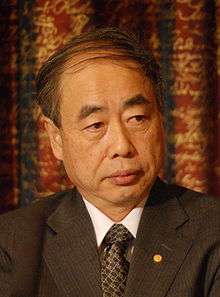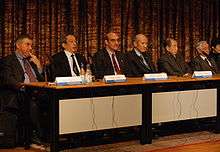Makoto Kobayashi (physicist)
| 小林 誠 Makoto Kobayashi | |
|---|---|
 Kobayashi in 2008 | |
| Born |
April 7, 1944[1] Nagoya, Japan[2] |
| Citizenship | Japan |
| Alma mater | Nagoya University[1][2] |
| Known for |
Work on CP violation CKM matrix |
| Awards |
Sakurai Prize (1985) Japan Academy Prize (1985) Asahi Prize (1995) High Energy and Particle Physics Prize (2007) Nobel Prize in Physics (2008) |
| Scientific career | |
| Fields | High energy physics (theory)[2] |
| Institutions |
Kyoto University High Energy Accelerator Research Organization[1][2] |
| Doctoral advisor | Shoichi Sakata |
Makoto Kobayashi (小林 誠 Kobayashi Makoto) (born April 7, 1944 in Nagoya, Japan) is a Japanese physicist known for his work on CP-violation who was awarded one fourth of the 2008 Nobel Prize in Physics "for the discovery of the origin of the broken symmetry which predicts the existence of at least three families of quarks in nature."[3]
Early life and education
Makoto Kobayashi was born in Nagoya, Japan in 1944. After World War II ended, he was only two years old at the time, and he lost his father Hisashi. Kobayashi family's house rendered to ashes by the Bombing of Nagoya, so they stayed at his mother's (surnamed Kaifu) family house. One of Makoto's cousin, Toshiki Kaifu, were living in the same place, who later became Prime Minister of Japan.[4]
After graduating from the School of Science of the Nagoya University in 1967, he obtained a DSc degree from Graduate School of Science of the Nagoya University in 1972.[5] During college years, he receive guidance from professor Shoichi Sakata and others.
Career


After completing his doctoral research at Nagoya University in 1972, Kobayashi worked as a research associate on particle physics at Kyoto University. Together, with his colleague Toshihide Maskawa, he worked on explaining CP-violation within the Standard Model of particle physics. Kobayashi and Maskawa's theory required that there were at least three generations of quarks, a prediction that was confirmed experimentally four years later by the discovery of the bottom quark.
Kobayashi and Maskawa's article, "CP Violation in the Renormalizable Theory of Weak Interaction",[6] published in 1973, is the fourth most cited high energy physics paper of all time as of 2010.[7] The Cabibbo–Kobayashi–Maskawa matrix, which defines the mixing parameters between quarks was the result of this work. Kobayashi and Maskawa were jointly awarded half of the 2008 Nobel Prize in Physics for this work, with the other half going to Yoichiro Nambu.[3]
In recognition of three Nobel laureates' contributions, the bronze statues of Shin'ichirō Tomonaga, Leo Esaki, and Makoto Kobayashi was set up in the Central Park of Azuma 2 in Tsukuba City in 2015.[8]
Professional record
- April 1972 – Research Associate of Kyoto University
- July 1979 – Assistant Professor of the National Laboratory of High Energy Physics
- April 1989 – Professor of the National Laboratory of High Energy Physics, Head of Physics Division II
- April 1997 – Professor of the Institute of Particle and Nuclear Science, KEK Head of Physics Division II
- April 2003 – Director, Institute of Particle and Nuclear Studies, KEK
- April 2004 – Trustee (Director, Institute of Particle and Nuclear Studies), KEK (Inter-University Research Institute Corporation)
- June 2006 – Professor emeritus of KEK.
Recognition
- 1979 – Nishina Memorial Prize
- 1985 – Sakurai Prize
- 1995 – Asahi Prize
- 2001 – Person of Cultural Merit
- 2007 – High Energy and Particle Physics Prize by European Physical Society
- 2008 – Nobel Prize in Physics
- In October 2008, Kobayashi was honored with Japan's Order of Culture; and an awards ceremony for the Order of Culture was held at the Tokyo Imperial Palace.
- 2010 – Member of Japan Academy
Personal life
Kobayashi was born and educated in Nagoya, Japan. He married Sachiko Enomoto in 1975; they had one son, Junichiro. After his first wife died, Kobayashi married Emiko Nakayama in 1990, they had a daughter, Yuka.[9]
See also
| Wikiquote has quotations related to: Makoto Kobayashi (physicist) |
References
- 1 2 3 "Makoto Kobayashi" (Press release). High Energy Accelerator Research Organization. 6 July 2007. Archived from the original on 9 October 2008. Retrieved 2008-10-04.
- 1 2 3 4 L. Hoddeson (1977). "Flavor Mixing and CP Violation". The Rise of the Standard Model. Cambridge University Press. p. 137. ISBN 0-521-57816-7.
- 1 2 The Nobel Prize in Physics 2008, The Nobel Foundation, retrieved 2009-10-17
- ↑ "英語、大嫌い 授賞式が初の海外 ノーベル賞益川氏". asahi.com(朝日新聞社). 2008-10-07. Retrieved 2009-11-26.
- ↑ Makoto Kobayashi - website of Nagoya University
- ↑ M. Kobayashi, T. Maskawa (1973). "CP-Violation in the Renormalizable Theory of Weak Interaction". Progress of Theoretical Physics. 49 (2): 652–657. Bibcode:1973PThPh..49..652K. doi:10.1143/PTP.49.652. Archived from the original on 2008-12-24.
- ↑ "Top Cited Articles of All Time (2010 edition)". SPIRES database. Retrieved 2014-06-21.
- ↑ ノーベル賞:江崎、小林、朝永氏の銅像やレリーフ設置 完成記念式でお披露目 「子どもが夢を」−−つくば・中央公園 /茨城 - 毎日新聞 Archived 2015-04-24 at the Wayback Machine.
- ↑ "Makoto Kobayashi (Autobiography)". The Nobel Foundation.
External links
| Wikimedia Commons has media related to Makoto Kobayashi. |
